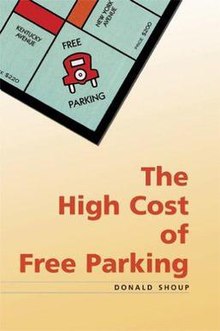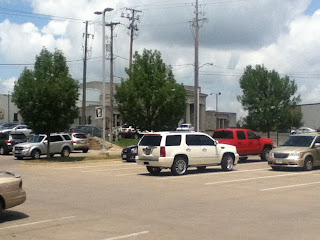| Shoup in Paris (Source: shoup.bol.ucla.edu) |
Donald Shoup, The High Cost of Free Parking (Planners Press, 2005)
Donald Shoup is an economist at UCLA who in 2005 published the definitive book on motor vehicle parking. It is a massive work (which alert readers will recognize as code for "I didn't read all of it"), painstakingly describing studies by himself and others. But it comes down to this: free curb parking creates all manner of problems for society. The solutions are to allow fewer parking spaces, charge more for parking, and (maybe) require limits on parking spaces.
Donald Shoup is an economist at UCLA who in 2005 published the definitive book on motor vehicle parking. It is a massive work (which alert readers will recognize as code for "I didn't read all of it"), painstakingly describing studies by himself and others. But it comes down to this: free curb parking creates all manner of problems for society. The solutions are to allow fewer parking spaces, charge more for parking, and (maybe) require limits on parking spaces.
One way towns have dealt with demand for parking on the street has been to require businesses (including medical facilities, schools and apartment buildings) to provide parking lots. This has resulted in a massive use of land for car-parking, particularly in certain areas. Surface parking lots are physically unattractive, waste space (and the money used to build them), and create vast empty areas in the town. Empty areas mean more space between places people are going, making people more likely to use cars; and they make those parts of town as a whole less attractive to people. If you're in Cedar Rapids and need a specific example, look at the area between 5th and 12th Sts, running pretty much from the interstate to the river, with a spur between New Bohemia and downtown. That's a lot of territory, and it is full of parking lots; if I had more time and research assistants, I'd count them, but it must run into multiple thousands of spaces.

There are several reasons for this phenomenon, but the most basic cause is city zoning requirements. Part I of the book (chs 2-10) details the extent of parking requirements for new construction, based on shaky or no data, and almost always excessive. Developers who wish to provide less parking must petition for an exemption, with uncertain prospects for success. Why governments persist in this irrationality is not clear, but it's probably some combination of (a) demands from the public, especially shoppers who want to park for free, and neighbors who want the shoppers parking somewhere besides in front of their houses; (b) impressive but false precision marketed by planning agencies; and (c) inertia.
It's not clear, though, that if governments backed off, the problem would vanish. (If so, Houston, Texas, which has no municipal zoning to speak of, would have solved this problem, to the envy and wonderment of all.) Developers and business owners have their own reasons for liking parking lots. In a society where a huge proportion of trips are made by motor vehicle, parking lots give customers somewhere to put their vehicles while they shop. Again, Cedar Rapids provides some instructive examples. The parking lot on the site of the former First Christian Church, and the one that required the closing of a block of 2nd Av, were initiated by the medical facilities, not by the city. Both have detracted from the urban fabric, but it's certainly easy to park there when you need to.
Shoup suggests several solutions, some small and some large. Cities should repeal minimum parking requirements; can provide central space(s) for public parking instead of requiring separate lots for each business; and/or encourage developers to provide incentives to customers and employees not to drive. More intensive solutions include market prices for parking spaces (explained in the video linked above, and detailed in chapters 15-21 of The High Cost of Free Parking). Today's technology allows for better adjustment of prices to varying demand at different times of day, and for more efficient collection of fees. (Many's the time I've lacked the right change to park at an open meter.) Political resistance to market-priced parking can be overcome by dedicating the revenue to pay for public services in the neighborhood.
Westwood Village is an example of an area with what Randolph T. Hester calls "impelling form" (a phrase I'm in love with, you may have noticed). A city is "impelling" when people are willing to endure some cost or inconvenience to get there. (The impelling nature of Chicago explains why businesses there haven't decamped en masse to Indiana, even though Indiana's taxes are lower than Illinois'.) As applied to parking, it matters enough to people to visit UCLA and/or the businesses around it that they are willing to pay market price for parking or take public transportation or walk. Pasadena has done even better than Westwood Village, coming from farther back (pp. 413-418). The vicious cycle described by Shoup that has dominated American towns since World War II--excessive supply of parking incentivizes driving while increasing space between businesses, thereby making walking harder and places less lively--is in such places reversed. Then it becomes a virtuous cycle, as parking lots are replaced by residences and businesses, making for a more lively and impelling town.
I, however, write to you from an under-confident college in an under-confident town. The under-confidence of Cedar Rapids is exemplified by our "Song of Dedication," which is written from the perspective of someone moving away. "Time and my life are like the river"... We'll miss this lovely town, but we're leaving. It's hard for the city to stand up for development when we're afraid businesses will leave for the hinterlands, and businesses are afraid they'll lose customers to outlying strips, if there isn't beaucoup parking. We don't get on the virtuous cycle if everyone deserts before we have a chance to become impelling. Shoup suggests Business Improvement Districts, like the Medical SSMID in Cedar Rapids, can be vehicles for collecting and spending parking revenue. But my conversations with Medical SSMID folk in May suggest they are more concerned with providing adequate amounts of parking for out-of-town patients than with filling in what is already a parking-rich empty quarter.
(These are rather poor pictures. You'd have to see the whole area from above to get the full effect.)
 | |||
| (This was taken at 11:00 on a Wednesday morning. Certainly we have no shortage of parking, just maybe not in exactly the right spots.) |
(The lot is mostly empty during the summer, but filled to capacity during the school year.)
In the hearing before the Board of Adjustment, Coe's representative expressed concern that the cars had to go someplace, and better a big parking lot than all over the streets. A city person wondered why Coe students had to all have cars. After all, Northwestern University bars students from having cars on campus for at least a year. Well, our representative responded, we're not Northwestern. And it's true that students aren't willing to endure as much to attend Coe as Northwestern students are willing to endure to attend Northwestern. Just so, Cedar Rapids isn't Chicago. And few churches around town would say they have a surplus of congregants. So they all build parking lots, too. How do towns like ours get off the vicious cycle?
OTHER STUFF
Donald Shoup website
"Freakonomics" podcast on parking's pricing problem (March 2013)
"The Shoupistas" Facebook group
Alan Durning, "What's in Your Garage?," Sightline Daily, 5 June 2013 [http://daily.sightline.org/2013/06/05/whats-in-your-garage/]... addresses parking requirements at individual residences, which I don't get into above, but which surely are an additional zoning absurdity. Thanks to John Heaton for sending this my way.






Save CR Heritage commentary and link to MedQuarter report on the parking surplus: http://savecrheritage.org/new-report-cites-overabundance-of-parking-in-cedar-rapids-medical-district-historic-church-was-demolished-for-parking-lot-last-year/
ReplyDelete